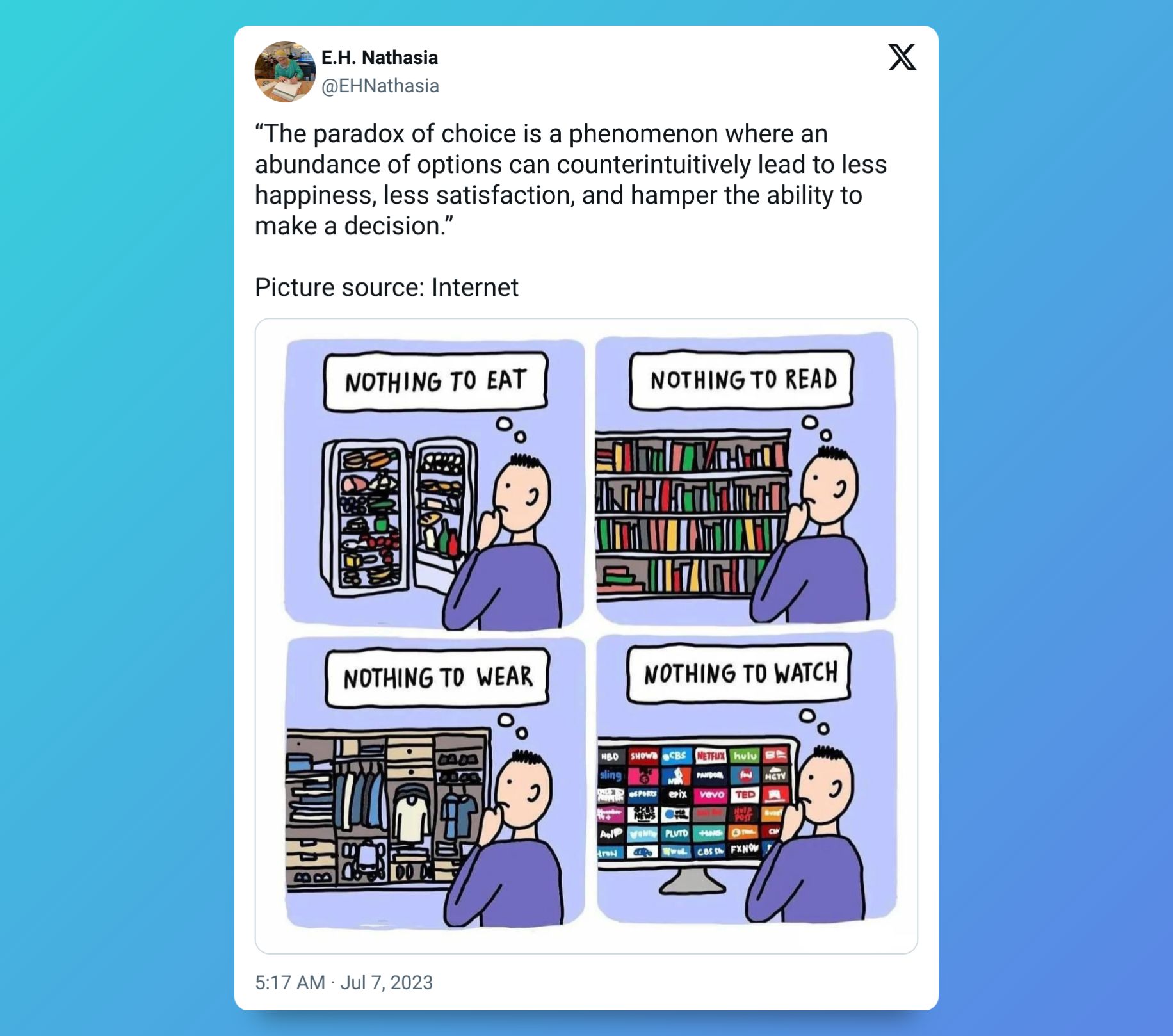- Startup Stoic
- Posts
- Less Is More: The Surprising Sales Power of Fewer Choices
Less Is More: The Surprising Sales Power of Fewer Choices
Why Simplifying Choices Can Skyrocket Your Conversions
You’d think that giving your customers more options would make them happier. After all, people love choices, right?
Not exactly.
Psychologists call it the “Paradox of Choice”—when too many options create anxiety, confusion, and decision paralysis. In the world of startup growth and digital product marketing, this translates to lost conversions, abandoned carts, and disengaged users.
In this Startup Stoic newsletter, let’s explore how reducing your offerings—strategically—can improve customer experience and supercharge sales.
Inventory Software Made Easy—Now $499 Off
Looking for inventory software that’s actually easy to use?
inFlow helps you manage inventory, orders, and shipping—without the hassle.
It includes built-in barcode scanning to facilitate picking, packing, and stock counts. inFlow also integrates seamlessly with Shopify, Amazon, QuickBooks, UPS, and over 90 other apps you already use
93% of users say inFlow is easy to use—and now you can see for yourself.
Try it free and for a limited time, save $499 with code EASY499 when you upgrade.
Free up hours each week—so you can focus more on growing your business.
✅ Hear from real users in our case studies
🚀 Compare plans on our pricing page
1. The Science Behind Choice Fatigue
A famous 2000 study by psychologists Sheena Iyengar and Mark Lepper put this to the test. They set up a jam tasting booth at a grocery store—some days with 24 flavors, other days with just 6.
Result?
More people visited the 24-flavor booth
But 10x more people actually bought from the 6-flavor booth
More options sparked interest, but fewer options drove action.
Startup Takeaway:
If you offer too many product tiers, CTAs, pricing plans, or features, you might overwhelm rather than engage.
2. Choice Overload = Drop-off Zones
Let’s say your SaaS platform has five pricing plans, each with slight feature differences, and a 20-line comparison table.
To your product team, it’s a masterpiece.
To a new visitor?
It’s friction. It causes:
Decision fatigue
Indecision and fear of making the wrong choice
Bounce or delay in conversion
Your user leaves—not because your product isn’t valuable—but because choosing felt like a chore.

A tweet on Choice Fatique
Startup Takeaway:
Simplify pricing pages. Trim to 2–3 clearly distinct tiers. Use one CTA per page, not five. Less cognitive load = more action.
3. Curated Paths Outperform Open Mazes
You know who does this well?
Apple: Three versions of the iPhone, clear differences.
Basecamp: A flat pricing structure—no analysis paralysis.
Slack: Simple free vs. paid model, with clear upgrade triggers.
They succeed by reducing options and clarifying which option is best for each user. They don’t rely on the customer to analyze—they guide them.
Startup Takeaway:
Map your buyer journey and remove forks in the road. The more obvious the path, the higher the conversion.
4. When to Trim—and When to Split
Don’t confuse simplicity with oversimplification. Instead:
Segment by audience: Tailor landing pages to a single persona or use case.
Bundle smartly: Instead of offering every feature à la carte, group them by need.
Run tests: A/B test fewer vs. more pricing tiers, simplified feature tables, or single-plan promos.
Think of this as progressive disclosure—only showing more options when users are ready.
Startup Takeaway:
Instead of cramming every detail upfront, design experiences that reveal value over time. Prioritize clarity over comprehensiveness.
5. Your Action Plan: Simplicity Sells
Here’s how to put this into action today:
Audit your site or app: Where are you offering too many choices—plans, features, product SKUs, CTAs?
Simplify interfaces: Can you reduce decisions on your homepage, checkout, or sign-up flow?
Clarify benefits: Instead of comparing features, show which option is best for which type of customer.
Use defaults wisely: Pre-select the best-fit option to reduce cognitive load.
Test minimalism: Run split tests on “3 choices vs. 6” or “highlighted plan vs. grid of options.”
Remember:
Customers don’t want every option. They want the right one, fast.
Final Thought
Steve Jobs once said,
“Deciding what not to do is as important as deciding what to do.”
The same is true in product and growth strategy. Offering fewer, smarter options can increase clarity, reduce friction, and turn browsers into buyers.
So, if your conversion rates are flat and bounce rates are high—it might be time to cut, not add.
More stories to get inspired…
Stay sharp, stay simple.
– The Startup Stoic Team



